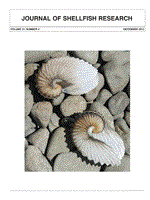Previous shellfish models have, in general, been calibrated for 1 location, unable to simulate growth across habitats that contrast in seston abundance and composition, as may vary between turbid, eutrophic and oligotrophic waters. Here, we describe the generic shellfish model ShellSIM, demonstrating how a common parameter set simulates growth effectively on calibration in the mussel Mytilus edulis and oyster Crassostrea gigas during normal culture across 9 different locations in Europe and China. Options enable the user to assess the relative values of chlorophyll a (CHL, measured in micrograms per liter), total particulate organic matter (POM; measured in milligrams per liter), and total particulate organic carbon (POC; measured in milligrams per liter) as codescriptors of the food available at separate locations. Using CHL as the sole proxy for available organics, together with an average carbon-to-CHL ratio of 50, growth in both M. edulis and C. gigas was predicted accurately at only 5 locations, primarily those with relatively low average food availability. In contrast, more than 74% of the observed variance in growth was predicted across all 9 locations in each species on inclusion of dynamic relations defining ingestion and absorption of both CHL-rich and all remaining organic matter such as may include bacteria, protozoans, colloids, and/or detritus, thereby helping to account for temporal and spatial changes in dietary composition. The energy content of the remaining organic matter (measured in Joules per milligram) ranged seasonally across all sites from about 2–25 J/mg, and could be predicted with growth from the relative abundance of CHL and POM alone, proving a viable alternative to more technically demanding measures of POC. Fractional contributions of the remaining organic matter to the energy absorbed in both species at each location ranged from less than about 0.4 during the spring to more than 0.8 from late autumn, in negative relation with CHL, thus helping to offset tissue wasting during winter months. We acknowledge model uncertainties, emphasizing the need to balance practicality and affordability against required accuracies. Last, we describe how the generic and multi-site capabilities afforded by ShellSIM, together with real-time outputs ready for integrated modeling of how shellfish influence ecosystem properties and processes, are saving time and resources across a variety of applications.
How to translate text using browser tools
1 August 2013
Shellsim: A Generic Model of Growth and Environmental Effects Validated Across Contrasting Habitats in Bivalve Shellfish
A. J. S. Hawkins,
P. L. Pascoe,
H. Parry,
M. Brinsley,
K. D. Black,
C. McGonigle,
H. Moore,
C. R. Newell,
N. O'Boyle,
T. Ocarroll,
B. O'Loan,
M. Service,
A. C. Smaal,
X. L. Zhang,
M. Y. Zhu
ACCESS THE FULL ARTICLE

Journal of Shellfish Research
Vol. 32 • No. 2
August 2013
Vol. 32 • No. 2
August 2013
bound water
Crassostrea gigas
detrital matter
mussel
Mytilus edulis
oyster
seston energy content




